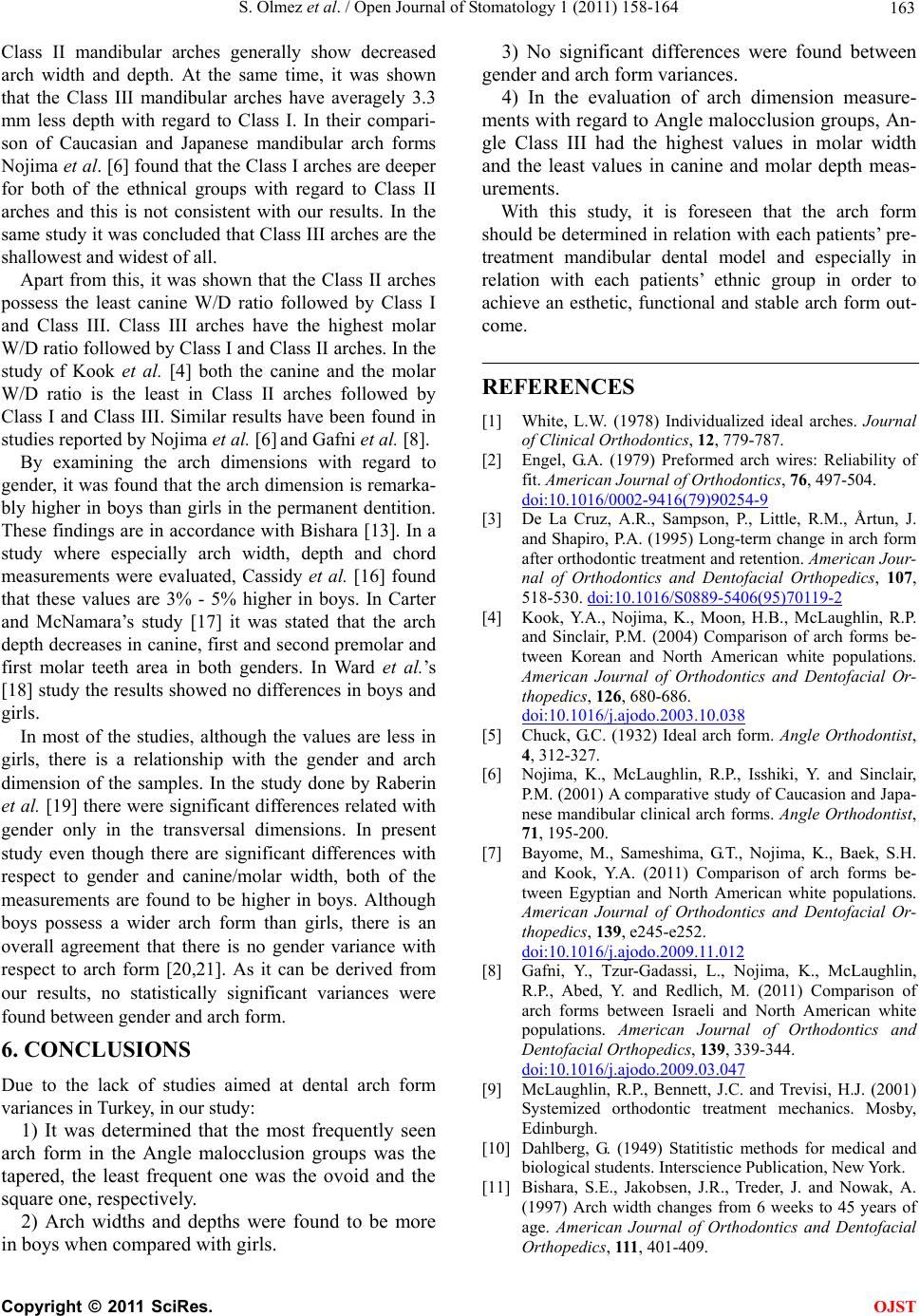
S. Olmez et al. / Open Journal of Stomatology 1 (2011) 158-164 163
Class II mandibular arches generally show decreased
arch width and depth. At the same time, it was shown
that the Class III mandibular arches have averagely 3.3
mm less depth with regard to Class I. In their compari-
son of Caucasian and Japanese mandibular arch forms
Nojima et al. [6] found that the Class I arches are deeper
for both of the ethnical groups with regard to Class II
arches and this is not consistent with our results. In the
same study it was concluded that Class III arches are the
shallowest and widest of all.
Apart from this, it was shown that the Class II arches
possess the least canine W/D ratio followed by Class I
and Class III. Class III arches have the highest molar
W/D ratio followed by Class I and Class II arches. In the
study of Kook et al. [4] both the canine and the molar
W/D ratio is the least in Class II arches followed by
Class I and Class III. Similar results have been found in
studies report ed by Nojima et al. [6] and Gafni et al. [8].
By examining the arch dimensions with regard to
gender, it was found that the arch dimension is remarka-
bly higher in boys than girls in the permanent dentition.
These findings are in accordance with Bishara [13]. In a
study where especially arch width, depth and chord
measurements were evaluated, Cassidy et al. [16] found
that these values are 3% - 5% higher in boys. In Carter
and McNamara’s study [17] it was stated that the arch
depth decreases in canine, first and second premolar and
first molar teeth area in both genders. In Ward et al.’s
[18] study the resu lts showed no differences in boys and
girls.
In most of the studies, although the values are less in
girls, there is a relationship with the gender and arch
dimension of the samples. In the study done by Raberin
et al. [19] there were significant differences related with
gender only in the transversal dimensions. In present
study even though there are significant differences with
respect to gender and canine/molar width, both of the
measurements are found to be higher in boys. Although
boys possess a wider arch form than girls, there is an
overall agreement that there is no gender variance with
respect to arch form [20,21]. As it can be derived from
our results, no statistically significant variances were
found between gender and arch form.
6. CONCLUSIONS
Due to the lack of studies aimed at dental arch form
variances in Turkey, in our study:
1) It was determined that the most frequently seen
arch form in the Angle malocclusion groups was the
tapered, the least frequent one was the ovoid and the
square one, respectively.
2) Arch widths and depths were found to be more
in boys when compared with girls.
3) No significant differences were found between
gender and arch form variances.
4) In the evaluation of arch dimension measure-
ments with regard to Angle malocclusion groups, An-
gle Class III had the highest values in molar width
and the least values in canine and molar depth meas-
urements.
With this study, it is foreseen that the arch form
should be determined in relation with each patients’ pre-
treatment mandibular dental model and especially in
relation with each patients’ ethnic group in order to
achieve an esthetic, functional and stable arch form out-
come.
REFERENCES
[1] White, L.W. (1978) Individualized ideal arches. Journal
of Clinical Orthodontics, 12, 779-787.
[2] Engel, G.A. (1979) Preformed arch wires: Reliability of
fit. American Journal of Orthodontics, 76, 497-504.
doi:10.1016/0002-9416(79)90254-9
[3] De La Cruz, A.R., Sampson, P., Little, R.M., Årtun, J.
and Shapiro, P.A. (1995) Long-term change in arch form
after orthodontic treatment and retention. American Jour-
nal of Orthodontics and Dentofacial Orthopedics, 107,
518-530. doi:10.1016/S0889-5406(95)70119-2
[4] Kook, Y.A., Nojima, K., Moon, H.B., McLaughlin, R.P.
and Sinclair, P.M. (2004) Comparison of arch forms be-
tween Korean and North American white populations.
American Journal of Orthodontics and Dentofacial Or-
thopedics, 126, 68 0- 68 6.
doi:10.1016/j.ajodo.2003.10.038
[5] Chuck, G.C. (1932) Ideal arch form. Angle Orthodontist,
4, 312-327.
[6] Nojima, K., McLaughlin, R.P., Isshiki, Y. and Sinclair,
P.M. (2001) A comparative study of Caucasion and Japa-
nese mandibular clinical arch forms. Angle Orthodontist,
71, 195-200.
[7] Bayome, M., Sameshima, G.T., Nojima, K., Baek, S.H.
and Kook, Y.A. (2011) Comparison of arch forms be-
tween Egyptian and North American white populations.
American Journal of Orthodontics and Dentofacial Or-
thopedics, 139, e245-e252.
doi:10.1016/j.ajodo.2009.11.012
[8] Gafni, Y., Tzur-Gadassi, L., Nojima, K., McLaughlin,
R.P., Abed, Y. and Redlich, M. (2011) Comparison of
arch forms between Israeli and North American white
populations. American Journal of Orthodontics and
Dentofacial Orthopedics, 139, 339-344.
doi:10.1016/j.ajodo.2009.03.047
[9] McLaughlin, R.P., Bennett, J.C. and Trevisi, H.J. (2001)
Systemized orthodontic treatment mechanics. Mosby,
Edinburgh.
[10] Dahlberg, G. (1949) Statitistic methods for medical and
biological students. Interscience Publication, New York.
[11] Bishara, S.E., Jakobsen, J.R., Treder, J. and Nowak, A.
(1997) Arch width changes from 6 weeks to 45 years of
age. American Journal of Orthodontics and Dentofacial
Orthopedics, 111, 401-409.
C
opyright © 2011 SciRes. OJST